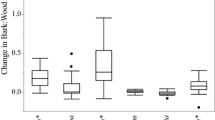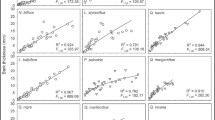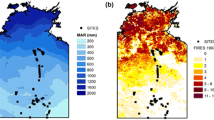Abstract
Key message
Bark thickness relative to stem diameter and radial stemwood and height growth patterns provided a more accurate discrimination of fire resistance than absolute bark thickness alone in juvenile stems.
Abstract
Thick bark provides thermal protection to cambial tissues and adventitious buds during fires, and thus, is a functional trait associated with more fire-resistant species and species persisting in fire-prone environments. However, bark thickness alone may not provide the best indicator of fire resistance due to differences among species-dependent growth, reproductive, and survival strategies. We measured bark thickness relative to radial stemwood and height growth among five juvenile co-occurring hardwood species following the Chips Fire (2012) in the southern Cascades, California. We found canyon live oak (Quercus chrysolepis) and Oregon white oak (Quercus garryana), the most fire-resistant, did not have the greatest bark thickness (0.7–0.4 mm; 0.8–0.3 mm), but rather had significantly greater relative (to stem diameter) bark thickness (8–18%) at all heights along the stem (p < 0.001). These species grew at slower rates: 48 and 41% shorter than the more fire-sensitive bigleaf maple (Acer macrophyllum; 2.9 m) and had 53 and 41% less diameter inside bark (DIB) than faster-growing, but less fire-resistant California black oak (Quercus kelloggii; 3.4 cm). Two discriminant functions (explaining 90% of variance) confirmed that separation of species was most strongly driven by DIB and relative bark thickness, accurately depicting species placement along a fire resistance spectrum (where Q. chrysolepis > Q. garryana > Q. kelloggii > Pacific dogwood, Cornus nuttallii > A. macrophyllum). Our findings highlight the importance of considering bark thickness relative to stem diameter and aboveground growth patterns in assessing species fire resistance.





Similar content being viewed by others
References
Adler PB, Salguero-Gómez R, Compagnoni A, Hsu JS, Ray-Mukherjee J, Mbeau-Ache C, Franco M (2014) Functional traits explain variation in plant life history strategies. Proc. Natl Acad Sci USA 111:740–745. https://doi.org/10.1073/pnas.1315179111
Agee JK (1993) Fire ecology of Pacific Northwest forests. Island Press, Washington, DC
Bond WJ, van Wilgen BW (1996) Fire and plants. Chapman and Hall, London
Charles-Dominique T, Midgley GF, Bond WJ (2017) Fire frequency filters species by bark traits in a savanna-forest mosaic. J Veg Sci 28:728–7350. https://doi.org/10.1111/jvs.12528
Clarke PJ, Lawes MJ, Midgley JJ, Lamont BB, Ojeda F, Burrows GE, Enright NJ, Knox KJ (2013) Resprouting as a key functional trait: how buds, protection and resources drive persistence after fire. New Phytol 197:19–35. https://doi.org/10.1111/nph.12001
Cocking MI, Varner JM, Knapp EE (2014) Long-term effects of fire severity on oak-conifer dynamics in the southern Cascades. Ecol Appl 24:94–107. https://doi.org/10.1890/13-0473.1
Coppoletta M, Merriam KE, Collins BM (2016) Post-fire vegetation and fuel development influences fire severity patterns in reburns. Ecol Appl 26:686–699. https://doi.org/10.1890/15-0225
Crotteau JS, Varner JM, Ritchie M (2013) Post-fire regeneration across a fire severity gradient in the southern Cascades. For Ecol Manag 287:103–112. https://doi.org/10.1016/j.foreco.2012.09.022
Fried JS (1985) Two studies of Acer macrophyllum: I. The effects of bigleaf maple on soils in Douglas-fir forest: II. The ecology of bigleaf maple seedling establishment and early growth in Douglas-fir forests, Thesis. Oregon State University, Corvallis
Graves SJ, Rifai SW, Putz FE (2014) Outer bark thickness decreases more with height on stems of fire-resistant than fire-sensitive Floridian oaks (Quercus spp.; Fagaceae). Am J Bot 101:2183–2188. https://doi.org/10.3732/ajb.1400412
Hammett EJ, Ritchie MW, Berrill J (2017) Resilience of California black oak experiencing frequent fire: regeneration following two large wildfires 12 years apart. Fire Ecol 13:91–103. https://doi.org/10.4996/fireecology.1301091
Hammond DH, Varner JM, Kush JS, Fan Z (2015) Contrasting sapling bark allocation of five southeastern USA hardwood tree species in a fire prone ecosystem. Ecosphere 67:1–13. https://doi.org/10.1890/ES15-00065.1
Hare RC (1965) Contribution of bark to fire resistance of southern trees. J For 63:248–251
Harmon ME (1984) Survival of trees after low-intensity surface fires in Great Smoky Mountains National Park. Ecology 65:796–802. https://doi.org/10.2307/1938052
Jackson JF, Adams DC, Jackson UB (1999) Allometry of constitutive defense: a model and a comparative test with tree bark and fire regime. Am Nat 153:614–632. https://doi.org/10.1086/303201
Keeley JE, Pausas JG, Rundel PW, Bond WJ, Bradstock RA (2011) Fire as an evolutionary pressure shaping plant traits. Trends Plant Sci 16:406–411. https://doi.org/10.1016/j.tplants.2011.04.002
Laughlin DC, Strahan RT, Moore MM, Fulé PZ, Huffman DW, Covington W (2017) The hierarchy of predictability in ecological restoration: are vegetation structure and functional diversity more predictable than community composition? J Appl Ecol 54:1058–1069. https://doi.org/10.1111/1365-2664.12935
Lavorel S, Garnier E (2002) Predicting changes in community composition and ecosystem functioning from plant traits: revisiting the Holy Grail. Funct Ecol 16:545–556. http://www.jstor.org/stable/826737
Lawes MJ, Richards A, Dathe J, Midgley JJ (2011) Bark thickness determines fire resistance of selected tree species from fire-prone tropical savanna in north Australia. Plant Ecol 212:2057–2069. https://doi.org/10.1007/s11258-011-9954-7
Lawes MJ, Midgley JJ, Clarke PJ (2013) Costs and benefits of relative bark thickness in relation to fire damage: a savanna/forest contrast. J Ecol 101:517–524. https://doi.org/10.1111/1365-2745.12035
McCune B, Grace JB (2002) Analysis of ecological communities. MjM Software Design, Gleneden Beach
Miles SR, Goudey CB (1997) Ecological subregions of California: section and subsection descriptions. USDA For Serv R5-EM-TP-005. Pacific Southwest Region, San Francisco
Miller M (2000) Fire autecology. In: Brown JK, Smith JK (eds) Wildland fire in ecosystems: effects of eire on flora. USDA For. Serv. Gen. Tech. Rep. RMRS-GTR-42-vol. 2. Rocky Mountain Research Station, Ogden, pp 9–34
National Oceanic and Atmospheric Administration (NOAA) (2011) Summary of Monthly Normals, 1981–2010. National Climatic Data Center. http://www.ncdc.noaa.gov/data-access/land-based-station-data/land-based-datasets/climate-normals/1981-2010-normals-data. Accessed 16 Dec 2015
Natural Resources Conservation Service (NRCS), USDA (2015) Web Soil Survey. http://websoilsurvey.nrcs.usda.gov/. Accessed 16 Dec 2015
Nemens D, Varner JM, Kidd KR, Wing B (2018) Do repeated wildfires promote restoration of oak woodlands in mixed-conifer landscapes? For Ecol Manag 427:143–151. https://doi.org/10.1016/j.foreco.2018.05.023
Pate JS, Froend RH, Bowen BJ, Hansen A, Kuo J (1990) Seedling growth and storage characteristics of seeder and resprouter species of Mediterranean-type ecosystems of S.W. Australia. Ann Bot 65:585–601. https://doi.org/10.1093/oxfordjournals.aob.a087976
Pausas JG (2015) Bark thickness and fire regime. Funct Ecol 29:315–327. https://doi.org/10.1111/1365-2435.12372
Paysen RE, Narog MG, Tissell RG, Lardner MA (1991) Trunk and root sprouting on residual trees after thinning a Quercus chrysolepis stand. For Sci 37:17–27
Rowe JS (1983) Concepts of fire effects on plant individuals and species. In: Wein RW, MacLean DA (eds) The role of fire in northern circumpolar ecosystems. Wiley, New York, pp 135–154
Roy DF (1955) Hardwood sprout measurements in northwestern California. USDA Res. Note 95. California Forest and Range Experiment Station, Berkeley
Schafer JL, Breslow BP, Hohmann MG, Hoffmann WA (2015) Relative bark thickness is correlated with tree distributions along a fire frequency gradient. Fire Ecol 11:74–87. https://doi.org/10.4996/fireecology.1101074
Schwilk DW, Gaetani MS, Poulos HM (2013) Oak bark allometry and fire survival strategies in the Chihuahuan Desert Sky Islands, Texas, USA. PLoS One 8:e79285. https://doi.org/10.1371/journal.pone.0079285
Shearman TM, Wang GG, Ma PT, Guan S (2018) Patterns of bark growth for juvenile trees of six common hardwood species in the eastern United States and the implications to fire-tolerance. Trees 32:519–524. https://doi.org/10.1007/s00468-017-1649-9
Shryock DF, DeFalco LA, Esque TC (2014) Life-history traits predict perennial species response to fire in a desert ecosystem. Ecol Evol 4:3046–3059. https://doi.org/10.1002/ece3.1159
Skinner CN, Taylor AH (2006) Southern Cascades bioregion. In: Sugihara NG, van Wagtendonk JW, Shaffer KE, Fites-Kaufman J, Thode AE (eds) Fire in California’s ecosystems. University of California Press, Berkeley, pp 195–224
Uhl C, Kauffman JB (1990) Deforestation, fire susceptibility, and potential tree responses to fire in the eastern Amazon. Ecology 71:437–449. https://doi.org/10.2307/1940299
VanderWeide BL, Hartnett DC (2011) Fire resistance of tree species explains historical gallery forest community composition. For Ecol Manag 261:1530–1538. https://doi.org/10.1016/j.foreco.2011.01.044
Varner JM, Kane JM, Hiers JK, Kreye JK, Veldman JW (2016) Suites of fire-adapted traits in the southeastern USA oaks: multiple strategies for persistence. Fire Ecol 12:48–64. https://doi.org/10.4996/fireecology.1202048
Violle C, Navas M, Vile D, Kazakou E, Fortunel C, Hummel I, Garnier E (2007) Let the concept of trait be functional! Oikos 116:882–892. https://doi.org/10.1111/j.2007.0030-1299.15559.x
Whittaker RH (1960) Vegetation of the Siskiyou Mountains, Oregon and California. Ecol Monogr 30:279–338. https://doi.org/10.2307/1943563
Wirth C (2005) Fire regime and tree diversity in boreal forests: implications for the carbon cycle. In: Scherer-Lorenzen M, Körner Ch, Schulze ED (eds) Forest diversity and function: temperate and boreal systems, Ecological Studies, vol 176. Springer, Heidelberg, pp 309–344
Wolfe BT, Saldaña Diaz GE, Van Bloem SJ (2014) Fire resistance in a Caribbean dry forest: inferences from the allometry of bark thickness. J Trop Ecol 30:133–142. https://doi.org/10.1017/S0266467413000904
Acknowledgements
Funding was provided by the USDA Forest Service Pacific Southwest Region and Pacific Southwest Research Station and the McIntire-Stennis Cooperative Forestry Research Program. We appreciate the assistance of Lassen and Plumas National Forest personnel, particularly P. Doyle and M. Hennessey. D. Nemens provided field assistance. Lab assistance was provided by E. Barker and D. Walker and laboratory equipment by C. Copenheaver at Virginia Tech. Discussions with B. Wing, J. Kreye, and D. Nemens helped shape the research. Earlier reviews by T. Shearman improved the manuscript.
Author information
Authors and Affiliations
Corresponding author
Ethics declarations
Conflict of interest
The authors declare that they have no conflict of interest.
Additional information
Communicated by H. Gärtner.
Rights and permissions
About this article
Cite this article
Kidd, K.R., Varner, J.M. Differential relative bark thickness and aboveground growth discriminates fire resistance among hardwood sprouts in the southern Cascades, California. Trees 33, 267–277 (2019). https://doi.org/10.1007/s00468-018-1775-z
Received:
Accepted:
Published:
Issue Date:
DOI: https://doi.org/10.1007/s00468-018-1775-z




